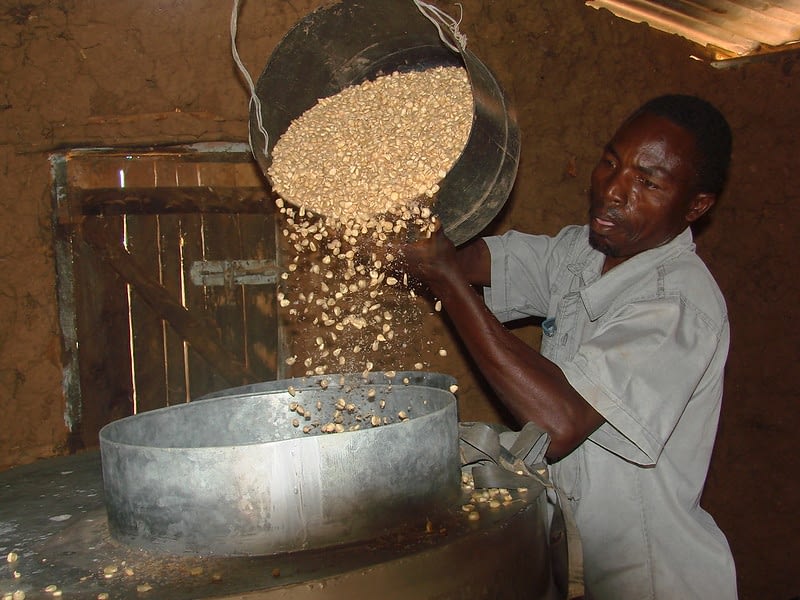Maize post-harvest losses in smallholder farming systems in sub-Saharan Africa have been shown to result in significant costs at household and national level, making it difficult to move towards achievement of SDG2 – Zero Hunger.
Within smallholder farming systems, new grain storage technologies such as metal silos can help reduce these losses during storage. However, technologies are often introduced into systems with complex sets of relationships, which may differentially affect the ability of women and men to secure the expected benefits. This, in turn, can have a knock-on effect on adoption rates and expected outcomes.
A recent study by an international team of researchers investigated whether modern storage structures such as metal silos provide equal benefits to women and men farmers in sub-Saharan Africa, using a mixed methods approach to explore the relationships governing maize production and storage in Kenya, Malawi, Zambia and Zimbabwe, where 1717 metal silos have been introduced through the Effective Grain Storage Project (EGSP).
The authors used random sampling to carry out quantitative surveys on metal silo owners in Kenya (124 respondents) and Malawi (100 respondents). Qualitative surveys using purposive sampling were also conducted in all four countries covering 14 ethnic groups using focus group discussions (360 respondents), key informant interviews (62 respondents), and household case studies (62 respondents). “Our aim was to understand gendered post-harvest management and storage strategies in traditional systems and to map changes when metal silos were introduced,” explain the authors.
“We hypothesized that existing gender norms might differentially influence women’s ability to benefit from the introduction of metal silos and our findings seem to indicate that this is correct. In most instances when metal silos are introduced, ownership of the grain storage facility and any benefits attached to that ownership typically switch from women to men, or men’s existing control over stored maize is deepened.”

Their findings highlight that roles and responsibilities regarding the ownership and management of storage structures are strongly gendered. Though there are differences between ethnic groups and countries, overall men benefit more than women from the introduction of metal silos. Ownership of a grain storage facility and the benefits attached to this ownership can switch from women to men, with women having less scope for bargaining over their rights to use the stores for their own needs and the benefit of all household members.
Many of the women interviewed suggested that this compromised their ability to access sufficient maize because men might insist on taking any grain set aside to meet their personal needs. “We did not measure how much grain is taken and whether food security is indeed negatively affected, but our research registers that women are concerned about this issue.”
The qualitative research explored whether ownership over the granary — and control over the maize stored within — changed when metal silos were purchased. In all four countries, cultural norms tend to result in men typically owning all large household assets such as land, water pumps, ox-ploughs and carts, etc. They generally make key decisions about how these assets are to be used as well. Furthermore, the income differential between women and men in male-headed households means that it is considerably more difficult for women than men to make a large purchase like a metal silo. “As a consequence of these factors, we found men were more likely to own metal silos in each country.”
There is some differentiation between ethnic groups. In Zimbabwe, for example, Zezuru women who had previously owned and managed a dura — a traditional granary — lost control over maize grain reserves when metal silos were introduced. But for Korekore women nothing changed: men had always controlled traditional storage technologies and the maize within, and they continued to do so when metal silos were introduced. These examples highlight the fact that despite the cultural differences between ethnic groups, Zimbabwean women lost out across the board when metal silos were introduced, either through losing control over storage structures, or because male ownership was not challenged.
In light of these findings, the authors argue that understanding social context is key to designing and disseminating post-harvest technologies that meet the needs and preferences of both men and women farmers in various cultural contexts.
Their results make a strong case for ensuring that agricultural policy-makers prioritize the provision of equal access to improved technologies, as this is crucial not only for supporting women to meet their individual production goals, but also for ensuring that household-level food security needs are met.
Read the full study “Do metal grain silos benefit women in Kenya, Malawi, Zambia and Zimbabwe?” in the Journal of Stored Products Research.

